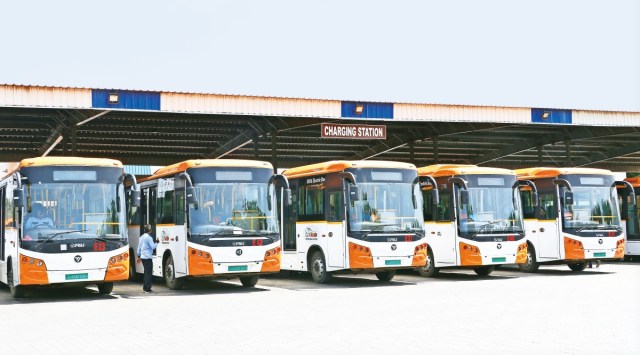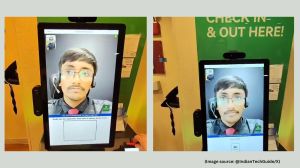Gujarat Hardlook: Buses on green fuel — Rajkot shifts gears
Rajkot has seen many transitions since the 1980s when a major means of public transport were autorickshaws or chhakdas — ‘uncomfortable’ multi-seater rides improvised from motorbikes. A complete transition to buses running on green fuel is on its way after many experiments.
 The wide windshields and windows, quieter gearless engines and air-conditioned cabins set the white and saffron e-buses far apart from the diesel-run buses of the Rajkot Mass Transport Service (RMTS).
The wide windshields and windows, quieter gearless engines and air-conditioned cabins set the white and saffron e-buses far apart from the diesel-run buses of the Rajkot Mass Transport Service (RMTS). When Chief Minister Bhupendra Patel flagged off a batch of 25 new e-buses of the Rajkot Municipal Corporation (RMC) earlier this month, the electric bus share in the fleet of 117 buses in the city rose to 75 per cent. This has been the highest for a public bus service in any Gujarat city.
The transition to e-mobility and green fuel-powered vehicles marks a paradigm shift in the city bus services in Rajkot, the fourth largest city of Gujarat, located in the heart of the Saurashtra region.
The wide windshields and windows, quieter gearless engines and air-conditioned cabins set the white and saffron e-buses far apart from the diesel-run buses of the Rajkot Mass Transport Service (RMTS). Operated by the RMC’s Special Purpose Vehicle (SPV), Rajkot Rajpath Limited (RRL), the buses also run on the dedicated BRTS (Bus Rapid Transit System) tracks, and have CCTV cameras that show the driver the movement of passengers.
 Many commuters now prefer e-buses over diesel-run buses that dominated the roads in Rajkot in the past. Express
Many commuters now prefer e-buses over diesel-run buses that dominated the roads in Rajkot in the past. Express
‘Pleasant ride’
Jyotsna Agrawat (51), who works as a domestic help and uses the e-bus for her commute, says, “E-buses are much better than the diesel buses as they are air-conditioned”.
Bus drivers seem to be equally pleased. “Driving an e-bus, which is much more comfortable, is rather a pleasant experience. Air-conditioned with gearless engines, and having better control systems, the buses have CCTV cameras that ensure that passengers have boarded or deboarded safely and any untoward incident is recorded,” says Bhagirathsinh Jadeja (26), a driver. He recalls driving the RMTS “blue bus” for four years before being hired by MPI Electro in September last year to drive an e-bus.
The Transition
Officials say that the entire RRL fleet will transition from diesel-powered buses to e-buses and CNG buses by the end of this calendar year or early next year. Also the fleet size will increase by 2.5 times to 250 buses, officials add. “We are going to add 75 more electric buses and 100 CNG (compressed natural gas) powered buses in the city bus fleet over the next few months,” Rajkot Mayor Pradip Dav says.
Anil Dhameliya, Deputy Municipal Commissioner of Rajkot says that the city bus services are in for a complete overhaul. “Over the next four months, we will phase out all our diesel buses as we induct 75 more e-buses and 100 CNG buses. That will increase our fleet size to 250 buses. Additionally, Rajkot has been selected as one of the beneficiary cities for the PM e-Bus Sewa scheme under which we will get 100 more e-buses. When those buses are delivered, our fleet size will further increase to 350 buses, allowing us to improve services and bring more areas under city bus service coverage,” Dhameliya says.
Tenders have already been floated for 100 CNG buses, RLL officials say. “We awarded a contract to PMI Electro Mobility Solutions Pvt Limited last year to supply 100 e-buses. The company delivered the first batch of 25 e-buses out of those 100 recently and they were flagged off by the Chief Minister on September 4. We have also floated tenders for 100 CNG buses for our city bus operations. Private firms have submitted their bids for the CNG buses and we are assessing those bids,” shares Alpana Mitra, General Manager (GM), RRL..
As per a 2018 Oxford Economics report, Rajkot is among the world’s 10 fastest growing-cities. Around 28,000 people ride the city buses every day, as per officials, and around 25,000 ride the BRTS buses daily. Besides the city limits, the city bus service also serves neighbouring villages.
Officers of the RMC say that the state-owned Gujarat State Road Transport Corporation (GSRTC) ran the city buses till 2004-05 but they were said to be grossly inadequate. The key roads in the city were enveloped in smoke during mornings and evenings as petrol and kerosene powered auto-rickshaws crowded the roads.
“I don’t think the public transport has been very reliable in Rajkot,” remarks Sudhir Sinha, a retired IPS officer who served as the Rajkot Police Commissioner from 1998 to 2001, and again in 2008. He was a part of the drive to clear the city of polluting vehicles.
After the GSRTC halted its buses, there was no public transport available in the city for the next year-and-a-half. Eventually, in 2006-07, the RMC awarded a contract to Raj City Bus Service, a Junagadh based-firm to provide city bus service on a net-cost model wherein the private firm brings in buses, operates them on city roads, collects fares and pays a fixed amount as premium to the civic body.
Five years later, the RMC hired Vallabhipur Transportation Cooperative Society Pvt Limited (VTCOS) to run the bus services in Rajkot in 2011-12 as the performance of Raj City Bus service began deteriorating.
In a few months, Bhavnagar-based VTCOS stopped its service abruptly due to operational losses under the net-cost model. In the meantime, the RRL started operating buses on its 10.7 km long BRTS corridor connecting Gondal Chowkadi to Madhapar Chowkadi on 150-feet Ring Road in October 2012.
The RMC, officials say, changed its policy and invited bids from private players to offer city bus services on a gross cost contract (GCC) model where the private player brings in the buses and drivers and the RMC pays the private firm on a per-kilometer basis while fare collection revenue goes to the RMC kitty.
The city bus services resumed in late 2013 after the RMC hired Shri Maruti Travels, an Ahmedabad-based firm for providing services on GCC and named the service Rajkot Mass Transport Service (RMTS). A year later, the RMC merged the RMTS with the RRL, the company the civic body had originally incorporated for running BRTS buses. Shri Maruti Travels continues to run RMTS buses till date while BRTS operations have been overtaken by PMI Electro since October 2021 onwards.
“While the original seven-year contract with Shri Maruti Travels has expired, the private firm continues to provide city bus services in Rajkot on extension,” Mitra, the RRL GM, says.
The transition to e-mobility began in 2019 when the Union Ministry of Heavy Industries sanctioned 50 electric buses under its Faster Adoption and Manufacturing of (Hybrid &) Electric Vehicles in India (FAME), phase-II. PMI Electro, the Delhi-based manufacturer of electric commercial vehicles, supplied its first batch of 25 buses to RMC in late 2021.
The RRL replaced its entire fleet for BRTS corridor with e-buses in October 2021 and deployed the rest for RMTS operations.
At present, Mitra says, 20 e-buses ply on the BRTS corridors and the rest on RMTS routes. Currently, the RRL uses 40 standard buses (12 metres long) and 40 midi buses for RMTS services. Within a few days, the number of midi diesel buses will come down to just 15 as the 25 e-buses flagged off by the CM are expected to start rolling out on city roads. “We are first replacing midi buses with e-buses as replacing one standard bus requires three e-buses in terms of seating capacity,” says the GM. Each electric bus costs around Rs1.2 crore against around Rs 35 to 40 lakh for a diesel or CNG bus. Under the FAME-II scheme, the central government is paying a one-time grant worth Rs 45 lakh per bus to PMI Electro towards government assistance for supplying buses to civic bodies. RMC is paying Rs53.95 per km to PMI for the 50 buses contracted in 2019 and will pay around Rs47 for the 100 additional e-buses contracted in 2022. “The e-buses will help us prevent air and noise pollution in the city. Additionally, they will also reduce operations cost in the longer run,” Mitra says, adding that the RRL is paying 75.77 per km to Shri Maruti Travels for standard buses.
‘Low frequency an issue’
The RMC has helped PMI Electro set up a charging station-cum-workshop having 16 chargers and a workshop near the Amul Circle on Bhavnagar Road. “Recharging a bus with double guns typically takes 35 to 40 minutes while it is somewhat longer if charged with single gun. However, we have enough capacity to recharge and service our buses,” Ashwini Kumar, PMI Electro’s depot manager, says.
Commuters, however, complain about the low frequency of bus trips. “Ticket rates in city bus services are reasonable but I don’t get buses that frequently. Therefore, I have to take my bike to my office near Greenland Chowkadi every day,” Keval Andani (22), a sales executive with a fast-moving-consumer goods company who lives in Ahir Chowk of the city says, adding, “I do prefer to travel by city buses on my off days.”
After a pilgrimage to Chotila in Surendranagar district, Tulsi Gohel (65), a tailor, and his wife Ila, complain they had been waiting for more than half an hour at Trikon Baug to catch a bus to Om Nagar for returning home. “Due to my age, I have stopped riding a scooter and prefer to travel by city buses only. But the frequency of buses is not that great. RMC needs to double its fleet size to ensure people don’t have to wait for long,” Gohel says. Agrawat, who is a native of Porbandar but has been living in Rajkot for 20 years also finds the BRTS buses crowded. “I admire city bus services for many reasons but the only solution is to increase the number of buses,” Agrawat says.
A number of students also depend on city buses to reach their schools and colleges. “Sometimes, buses are crowded and we feel like auto-rickshaws can be better options. But then, auto-rickshaws charge Rs 20 for a one-day trip while fare in a city bus is half of it. We can’t afford such high fares for daily trips,” Kunjal Jotaniya (19), daughter of a daily wager who travels from her home in Khodiyarnagar to a college in Rashtriya Shala, says.
RM Vadiya (77), a homeopath also rides city buses once a week from his residence in Punitnagar in the western part of the city to Trikon Baug in the heart of the city to purchase medicines.“The city bus service in Rajkot has modernised from the time of the GSRTC buses. We can safely call our service the second best in the state after Ahmedabad’s. In Ahmedabad, one gets a bus per 15 minutes but here it could be as long as an hour,” says the septuagenarian who travels by bus for safety it offers.
Mitra agrees that RRL does need more buses. “For a city with a population around 18 lakh, we need around 400 buses to keep the frequency reasonably high. But the RRL revenue was Rs 24 crores less in 2022-23 than the annual cost of running the city bus service and the RMC has to cross fund this gap. Passenger load factor is also a big issue as people are not embracing city bus service wholeheartedly. However, the addition of 74 more electric buses and 100 CNG buses should solve many problems,” he says.
Can the dependence on public transport increase in the coming times? Vijay Anadkat, a program senior fellow at World Resource Institute (WRI), India, says the preference of city dwellers in India continues to be private vehicles because fuel prices are still affordable and parking is almost free.
“The advent of e-scooters can reinforce such preferences. It’s a vicious cycle in which people say they don’t use public transport as bus frequency is low and urban civic bodies dither from expanding from their city bus fleets due to low passenger load factor. But the policy direction can be to have an efficient city bus service and then try to change people’s attitude towards it through information, education and communication campaigns,” Anadkat, who has served as a city engineer of RMC, says.
(With inputs from Ritu Sharma in Ahmedabad, Kamaal Saiyed in Surat & Aditi Raja in Vadodara)
Bus service in other cities
AHMEDABAD
The Ahmedabad Municipal Transport Service (AMTS) has a total fleet of 795 buses with an average daily ridership of 4.31 lakh. Nearly all AMTS buses run on CNG, except 57 diesel buses which will be discarded by the end of 2023, says a senior AMC official.
The AMTS plans to add another 200 CNG buses by the end of this year. Another 100 CNG AC midi buses will be added for which the RPF (request for proposal) is under process. Besides the AMTS, Ahmedabad Janmarg Limited, an SPV of Ahmedabad Municipal Corporation (AMC), operates a fleet of 321 buses in BRTS corridor in Ahmedabad, — 200 are electric buses nearly 50 are CNG buses, and 70 are diesel-run buses.
The BRTS buses have a daily ridership of two lakh passengers and a daily income of Rs 28.5 lakh.
With 90 km of dedicated corridor and 60 km of mixed stretch, the BRTS buses cover a total of 150 km of distance through 18 km in the city. Another 300 electric buses are planned to be added to the fleet within a period of 1.5 to 2 years.
Surat
A total of 575 diesel buses and 225 electric buses ply on city roads and BRTS corridors. The Surat Municipal Corporation (SMC) has given contracts to three firms to provide city bus services in the city.
Deputy Commissioner of SMC Kamesh Naik says, “All these 800 buses are used for 8,500 trips in the city in a day.
By December, we will get 150 more e-buses. We have also requested 450 e-buses buses under different schemes from the central government,” Naik says, adding, “We are planning to scrap all the diesel-run buses in the next couple of years.” He further adds that over 2.5 lakh people ride daily by city buses in Surat.
Vadodara
The Vadodara Municipal Corporation (VMC) runs 150 VTCOS city buses, plying on 60 planned routes. VMC Executive Engineer (Mechanical) Dharmesh Rana says, “Currently our buses operate on regular fuel. We have a proposal in process to convert some of the buses to green fuel (hydrogen) with the help of the Indian Oil Corporation Limited, soon.”
The VMC Standing Committee has also cleared a proposal to form an SPV for implementing a public transport project with the deployment of 200 e-buses.











